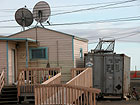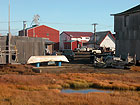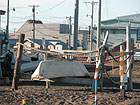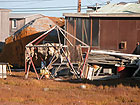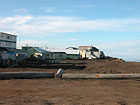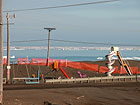

 | |||||||||||||||||||||||||||||
|
|
Journals 2006/2007Kirk Beckendorf
September 6, 2006 I had not had much opportunity to see Barrow itself, not that it takes that long to see. It is a mile or two away from BASC, along the dirt road following the beach. I have been into town a few times but always going to a specific destination and usually with limited time. This morning I borrowed the truck and went to town just to look around. The mileage sign across the road from the airport shows that Barrow, a town of 4500, is closer to the North Pole than it is to most places in the United States. Barrow is an interesting mix of new and "old". Meats (seal skin boats) on top of oil drums are seen beside powerboats. Drying caribou hides under power lines. Sleds and satellite dishes are found at the same house. It is a town that depends on hunting not as a sport but as way of obtaining food. Whales and other marine mammals are major sources of food. Changes in the whale population or in their migration pattern will have an impact on this community. As a result the local whaling captains support Carin's groups search for an understanding of the whale's ecosystem.
At first glance Barrow gives the appearance of a dismal place. I try to remove the ethnocentric biases I bring with me from the lower 48, where a person's status is often associated with outward appearances. Instead I try and understand the local situation. At home I spend hours trying to make my flowerbeds and yard the envy of the neighbors. Here in Barrow the harsh climate and its remoteness do not lend themselves to the luxury of manicured lawns, flower gardens and spotless yards. The grassy tundra on which Barrow is built can't survive under the foot traffic that occurs around a house or in a town. Consequently most of the ground around the homes is mostly dirt or gravel. Even the local playground is gravel. Piles of materials are seen around many homes. Because everything has to be brought to Barrow by plane or boat, supplies are expensive and may not be readily available. (To put the remoteness in perspective- the Sitka High School football team flew about 1000 miles to come here.) People are reluctant to just throw things away. One never knows what part of an old refrigerator; dishwasher, four-wheeler, old lumber or car can be salvaged.
Later this afternoon we went back out to the boat and into the Beaufort Sea. I realized that it would be my last time out with this awesome team of scientists who have been so supportive of me participating in their research. It was a fitting that on my final day at sea we detected the entire bowhead's food chain- we saw a whale, caught a lot zooplankton, and instruments detected a lot of chlorophyll (indicating phytoplankton). In addition we saw thousands of shearwaters, many seals and even two porpoises. Low-lying clouds slowly hid the clear sunny skies that we had been enjoying the past few days. As we made our way back to shore it turned foggy and began to rain, the way it was when I arrived about two weeks ago. Question of the Day: How would you enjoy living in such a remote and wild place? |
||||||||||||||||||||||||||||
